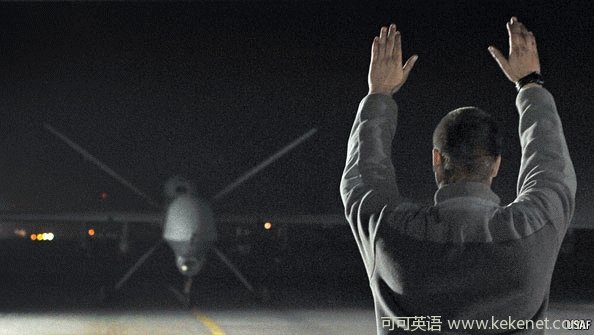
Science and Technolgy.
科技。
Pilotless aircraft.
無人機。
Giving drones a thumbs up.
向無人機打手勢。
How to integrate the control of piloted and pilotless aircraft.
如何讓指揮有人機的方法適用于無人機。
DECK officers on American aircraft carriers use hand gestures to guide planes around their vessels. These signals are fast, efficient and perfect for a noisy environment. Unfortunately, they work only with people. They are utterly lost on robotic drones-and even if a drone is under the control of a remote pilot deep in the bowels of the ship, that pilot often has difficulty reading them. Since drones are becoming more and more important in modern warfare, this is a nuisance. Life would be easier for all if drones were smart enough to respond directly to a deck officer’s gesticulations.
在美國的航空母艦上,甲板指揮員會用手勢指揮母艦附近的飛機。這種信號快速、高效,而且十分適用于嘈雜的環(huán)境。但遺憾的是,只有人才能讀懂這些手勢。在無人機上,這一套完全失效;而即便有飛行員在船艙深處遠程操控這架飛機,他往往也很難識別那些手勢。這是個麻煩,因為無人機在現(xiàn)代戰(zhàn)爭里變得越來越重要了。若無人機的智能達到了足以直接響應(yīng)甲板指揮員手勢的程度,那一切都會好很多。
Making them that smart is the goal of Yale Song, a computer scientist at the Massachusetts Institute of Technology. He is not there yet but, as he reports in ACM Transactions on Interactive Intelligent Systems, he and his colleagues David Demirdjian and Randall Davis have developed a promising prototype.
讓無人機具備這樣的智能是麻省理工學(xué)院計算機科學(xué)家Yale Song的目標。這個目標雖尚未達成,不過正如他在《美國計算機學(xué)會交互式智能系統(tǒng)學(xué)報》所報告的,他和他的同事David Demirdjian和Randall Davis已開發(fā)了一個很有前景的原型系統(tǒng)。
To try teaching drones the language of hand signals Mr Song and his colleagues made a series of videos in which various deck officers performed to camera a set of 24 commonly used gestures. They then fed these videos into an algorithm of their own devising that was designed to analyse the position and movement of a human body, and told the algorithm what each gesture represented. The idea was that the algorithm would learn the association and, having seen the same gesture performed by different people, would be able to generalise what was going on and thus recognise gestures performed by strangers.
為了讓無人機讀懂手語,Yale Song和他的同事制作了一系列視頻,視頻記錄了多位甲板指揮員對著攝象機擺出的24個常用手勢。然后他們用一個自己設(shè)計的算法(用于分析人體的位置和動作)來處理這些視頻,并讓算法知道每個手勢的意義。他們的設(shè)想是,該算法會記住每個手勢所對應(yīng)的意義,而在對不同人擺出的相同手勢進行處理后能夠概括出手勢本身的意義,從而識別任何人擺出的手勢。
Unfortunately, it did not quite work out like that. In much the same way that spoken language is actually a continuous stream of sound (perceived gaps between words are, in most cases, an audio illusion), so the language of gestures to pilots is also continuous, with one flowing seamlessly into the next. And the algorithm could not cope with that.
很遺憾,實際與預(yù)想的不太一樣。其實指揮飛行員所用的手語和人說的話差不多。后者實際上是一串連續(xù)的聲音(人耳能察覺到的詞與詞之間的停頓在多數(shù)情況下只是聽覺上的錯覺),而手語同樣也是連續(xù)的,因為兩個動作之間是連貫的。但該算法無法處理這種連續(xù)的信息。
To overcome this difficulty Mr Song imposed gaps by chopping the videos up into three-second blocks. That allowed the computer time for reflection. Its accuracy was also increased by interpreting each block in light of those immediately before and after it, to see if the result was a coherent message of the sort a deck officer might actually wish to impart.
為了解決這個問題,Yale Song以3秒為一段將視頻截開,在各段之間插入時間間隔。這樣就給計算機留出了響應(yīng)時間。同時識別的準確率也有所提高。因為這樣計算機就能根據(jù)前一段及后一段的視頻來理解當前這一段,看看結(jié)果是不是那種甲板指揮員可能真的想擺出的有特定意義的手勢。
The result is a system that gets it right three-quarters of the time. Obviously that is not enough: you would not entrust the fate of a multi-million-dollar drone to such a system. But it is a good start. If Mr Song can push the accuracy up to that displayed by a human pilot, then the task of controlling activity on deck should become a lot easier.
他們最終做出了一個正確率為75%的系統(tǒng)。顯然,那樣是不夠的:你不會將一架價值數(shù)百萬美元的無人機交給這樣的系統(tǒng)。但這是個好的開始。若Yale Song能將無人機識別手勢的正確率提高至與真人飛行員相當,那么在甲板指揮無人機會容易得多。











